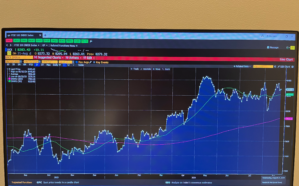 This summer marks my second participation in SPUR, the Summer Program for Undergraduate Research, at Wharton. As with last year, I engaged in SPUR with the goal of uncovering new insights through a self-directed research project. However, this time, I adopted a more quantitative approach, applying concepts I learned in the finance and statistics courses I have taken at Wharton. It was valuable to gain firsthand experience in conducting research in fields that require a more quantitative methodology to uncover findings.
This summer marks my second participation in SPUR, the Summer Program for Undergraduate Research, at Wharton. As with last year, I engaged in SPUR with the goal of uncovering new insights through a self-directed research project. However, this time, I adopted a more quantitative approach, applying concepts I learned in the finance and statistics courses I have taken at Wharton. It was valuable to gain firsthand experience in conducting research in fields that require a more quantitative methodology to uncover findings.
Last spring, I enrolled in the course International Financial Markets & Cryptocurrencies (FNCE2190), which provided an introduction to foreign exchange rates, international money markets, currency rate derivatives, and related topics. As I explored these subjects, I became increasingly interested in the factors that determine currency prices. I began to question why some currencies appreciate or depreciate seemingly at random and what the broader economic implications of these fluctuations might be. As an international student from Norway, I was particularly concerned about the significant depreciation of the Norwegian Krone against major currencies such as the Euro, US Dollar, and British Pound over the past decade. For instance, if I had pursued my education at Penn ten years ago, my purchasing power would have been nearly double what it is today. Understanding the factors contributing to this depreciation could be crucial in addressing this trend.
Before applying to the SPUR program, I conducted preliminary research on this topic and found that existing studies had not reached a definitive conclusion. While this uncertainty motivated me to investigate further, the limited availability of literature and data on the subject made it challenging to derive meaningful insights within the project’s timeframe. Consequently, I decided to pivot my focus. Rather than solely examining currency depreciation, I chose to study how such depreciation and heightened volatility impact the demand for currency-hedged ETFs that hold equities in non-U.S. countries. Although this question was broader, it also allowed me to explore one of the most popular investment vehicles of modern times: ETFs.

An Exchange Traded Fund (ETF) is an investment vehicle that holds a portfolio of assets and issues shares that are traded on exchanges, similar to shares of publicly listed companies. International ETFs specifically hold assets, such as equities or bonds, from non-U.S. countries, introducing currency risk in addition to the risks associated with the underlying assets. A currency-hedged ETF, on the other hand, mitigates these currency risks, allowing investors to focus solely on the return of the index the ETF follows in the foreign country.
My hypothesis was that, all else being equal, there would be an outflow of funds from unhedged equity ETFs into hedged equity ETFs in response to the depreciation or heightened volatility of the local currency. If this hypothesis held true, it would prompt further questions about the rationality of these investor actions. This could be evaluated by comparing the returns of hedged ETFs against their unhedged counterparts, accounting for local currency movements. If it were found that unhedged ETFs offer better returns over time, despite the prevailing investor preference for hedged options, this could indicate a market inefficiency. Investors could potentially capitalize on this by favoring unhedged ETFs when they are sold off, positioning themselves to benefit from an eventual market correction. Thus, this project was just as much an attempt to develop an investment strategy based on my very own research—a pretty exciting prospect!
After outlining the project and drafting my hypothesis, I began selecting the ETFs whose data I would use in the analysis. After a rigorous selection process, I ended up with 13 hedged and 17 unhedged ETFs holding equities in Germany, Japan, Korea, Mexico, the United Kingdom, and the Eurozone. From there, however, things did not proceed as smoothly.
The primary challenge of the project was undoubtedly acquiring data, such as outstanding shares, prices, and Net Asset Value (NAV) for these ETFs, for use in the analysis. To my surprise, much financial data is highly decentralized and not readily accessible to the public. Fortunately, being part of the SPUR program, I received invaluable assistance from Marcella Barnhart of the Lippincott Library, who helped me access reliable data sources, including Bloomberg and LSEG.
With the necessary data in hand, I was ready to perform the analysis. One of the benefits of conducting research is the opportunity to apply knowledge gained in the classroom. In my case, I performed several regression analyses, building on what I had learned in STAT4310 the previous semester.
Contrary to my expectations, neither the bivariate nor the multivariate regressions indicated a statistically significant relationship between currency depreciation or heightened volatility and inflows into hedged ETFs. The results showed that short-term index returns were the primary driver of increased inflows into hedged ETFs. This finding suggests that when the stock market in the country whose equities are held by the hedged ETF performs well, investors are more inclined to purchase shares of that ETF in pursuit of potential returns.

Although I initially felt some frustration with the insignificant results of the regression analyses, I came to appreciate that insignificance is also a valuable finding. It prompted me to consider which other variables not included in this analysis might explain fund flows into international ETFs—a question I am eager to explore in future research.
My summer, however, was not solely devoted to research. Like last summer, when I also participated in SPUR, I took the opportunity to explore the East Coast more thoroughly, enjoying the freedom of not having to manage my usual academic commitments. I visited the Barnes Foundation for the first time, tried nearly everything on Parc’s menu, and traveled to Washington, D.C., to experience the city. The flexibility of my research schedule also allowed me to develop an app and enhance my programming skills.
SPUR offered me a valuable opportunity to sharpen my critical thinking skills, improve my writing proficiency, and deeply explore a field of interest under the expert guidance of Professor Li, a highly knowledgeable researcher in the field. I strongly recommend SPUR to any student eager to gain insight into the research process. The program also serves as an excellent springboard for deeper engagement with the research community at Penn.


